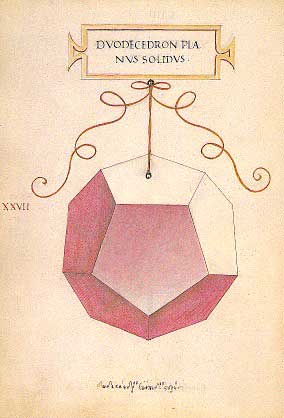Humanism mathematician Piero della Francesca Piero della Francesca
figures and solids by Piero della Francesca
In classical antiquity, the role of symmetry as a guiding principle in the design of the physical world was accentuated by the rarity of solid figures symmetric similar to regular polygons.
while over the floor we have an infinite number of regular polygons corresponding to the finite rotations, three-dimensional space can be made only five polyhedra Regular: cube, tetrahedron, the 'octahedron, dodecahedron, el' Icosahedron. These regular polyhedra called Platonic Solids are traditionally the key role they play in cosmology developed by Plato. Him in his dialogues, Timaeus, associated with the tetrahedron, octahedron, cube, icosahedron, respectively, and those who were then considered the four basic elements: fire, air, land and water. The dodecahedron, not achievable by combining appropriate triangles (as
for the other polyhedra mentioned), however, was associated with the image of the entire cosmos, creating the so-called quintessence. This identification suggests an image of perfection that no doubt arises from the fact that the dodecahedron, approximates most of the other regular polyhedra the ball.
The fortunes of the Platonic solids scientific imagination of Western culture has been enormous, and is perhaps related to a philosophical point of view it believed it could penetrate deeply into the secrets of creation looking at these statues in the world of Euclidean Plato's ideas. Art and science blend in a deep way in the Libellus de corporibus regularibus of Piero della Francesca. The idea that inspires such a project is of a singular modernity in the sense that you want to support (we are in the late fifteenth century), the prejudices against the humanities, such as science or pure abstraction is not only technical but also a liberal art.

0 comments:
Post a Comment